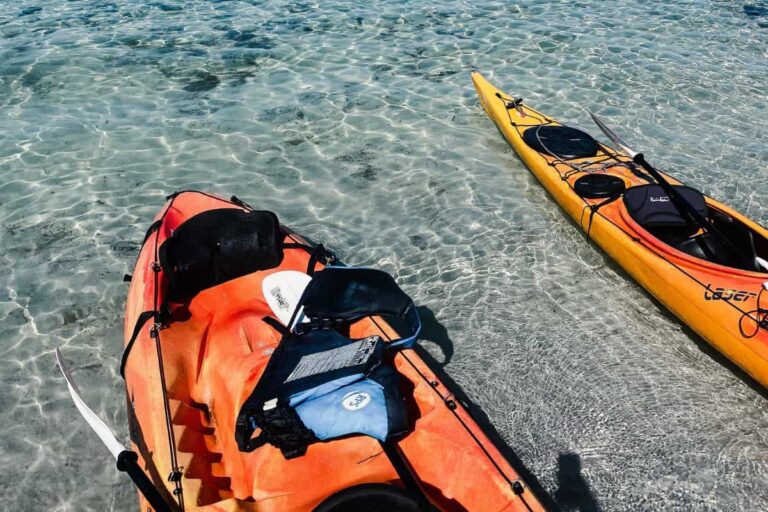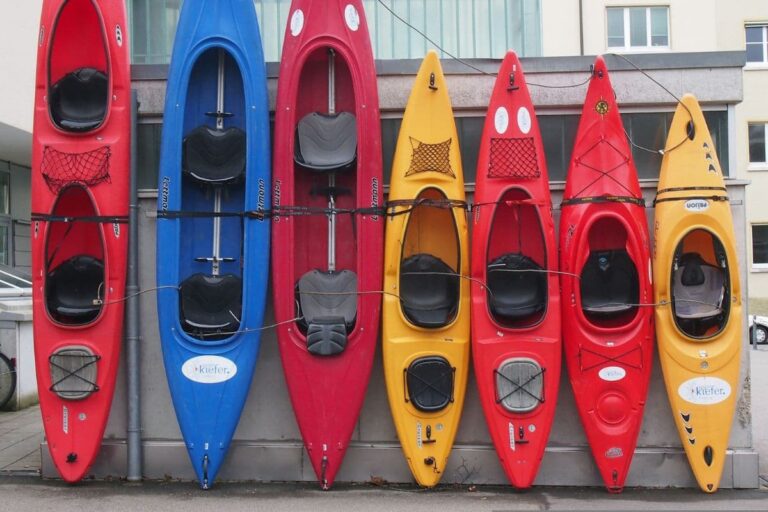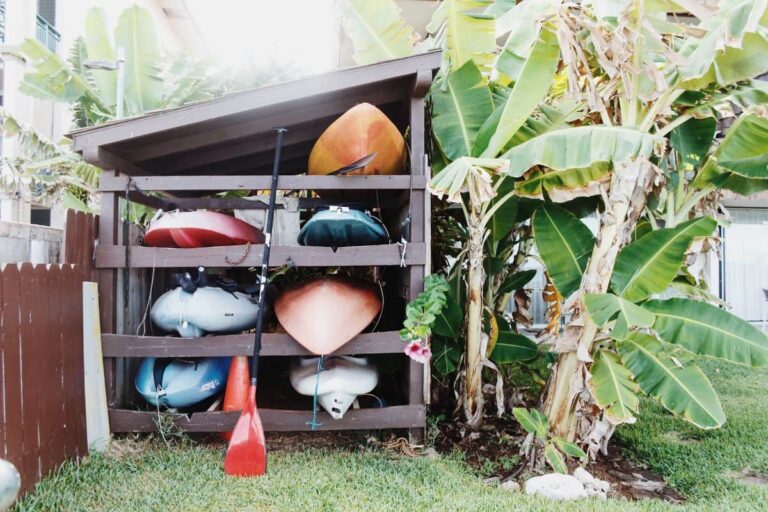What Are Kayaks Made Of? (Kayak Materials)
A kayak’s shape, length, and type will all directly impact how well the boat will function on different kinds of water. These factors also significantly affect how well the kayak can track (hold a straight line between paddles) and how fast it will go.
An even greater determinant in how a kayak will perform than the above mentioned characteristics is the type of material a kayak is made from Below, we’ll answer the question: “What are kayaks made of?”
Kayaks come in a variety of materials, including plastic (Polyethylene), ABS thermoform, inflatable kayaks, and fiberglass/carbon fiber or composite materials. Each of these various kayak materials offers its own set of pros and cons, which you’ll want to factor in before making your final decision on a kayak purchase.
We’ll also highlight the benefits and drawbacks of each of these options.
5 Popular Kayak Materials
Plastic (Polyethylene) Kayaks
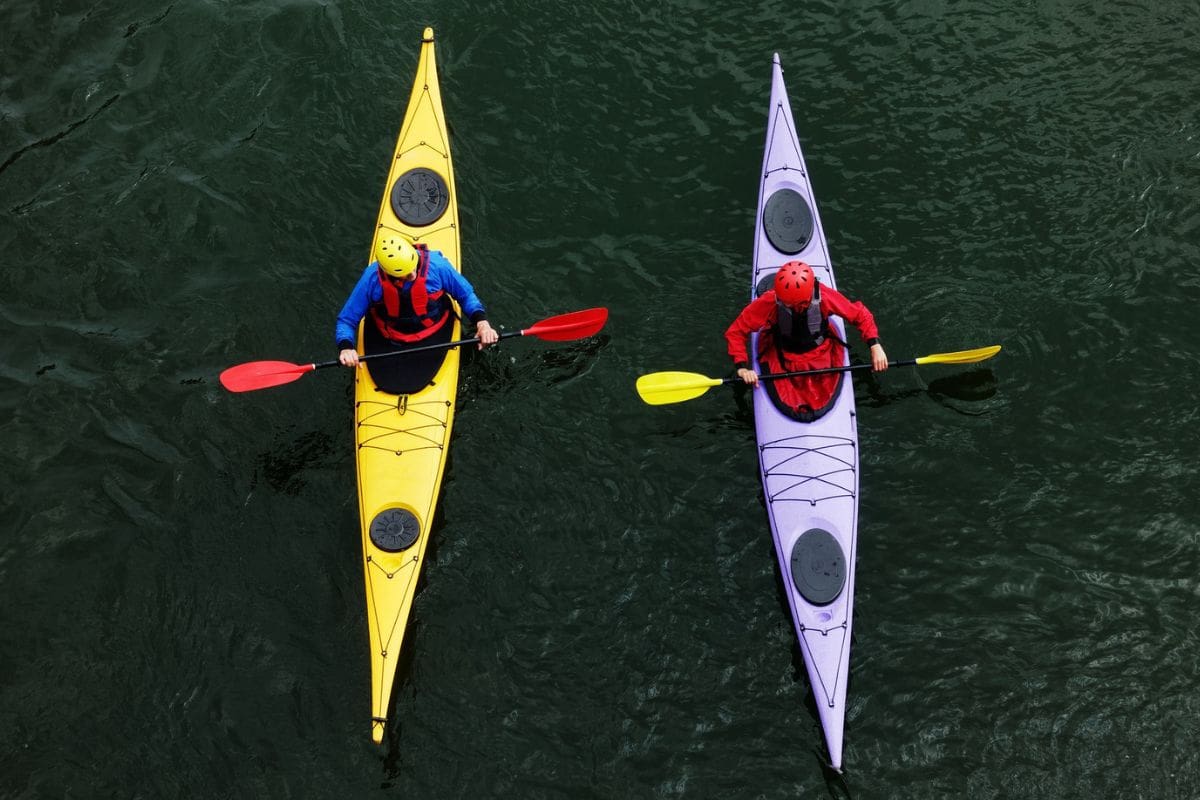
Plastic kayaks (sometimes called rotomolded polyethylene kayaks) have been a popular choice for touring kayaks since they first came on the market in the early 1970s.
To create these kayaks, plastic pellets are poured directly into a hollow metal hull mold.
The gel-coated mold is then heated evenly inside a huge oven and rotated – this process is called rotational molding – which allows the molten plastic polyethylene material to fill the entire mold.
After the kayak has had some time to cool down, it is popped out of the mold.
At this point, the finished kayak is just about water-ready.
The rotomolded plastic kayak is a perfect option for beginners, and the affordable price tag doesn’t hurt either!
Pros
The polyethylene plastic used in rotomolded kayaks is super robust.
This kind of plastic material can also be found in car body panels, food containers, and a variety of industrial applications.
Polyethylene kayaks work generally well for all water conditions because they’re versatile, super affordable, and maybe the most durable recreational boats on the market today.
Cons
Rotomolded plastic kayaks are incredibly durable because they are so thick and heavy, which also makes them more difficult to transport and carry.
Additionally, every dent, ding, and abrasion on the surface of your kayak will end up creating at least some drag.
That drag will compound over time, causing your kayak not to track as straight as it did before — and it certainly won’t be as fast as it used to be.
ABS Kayaks
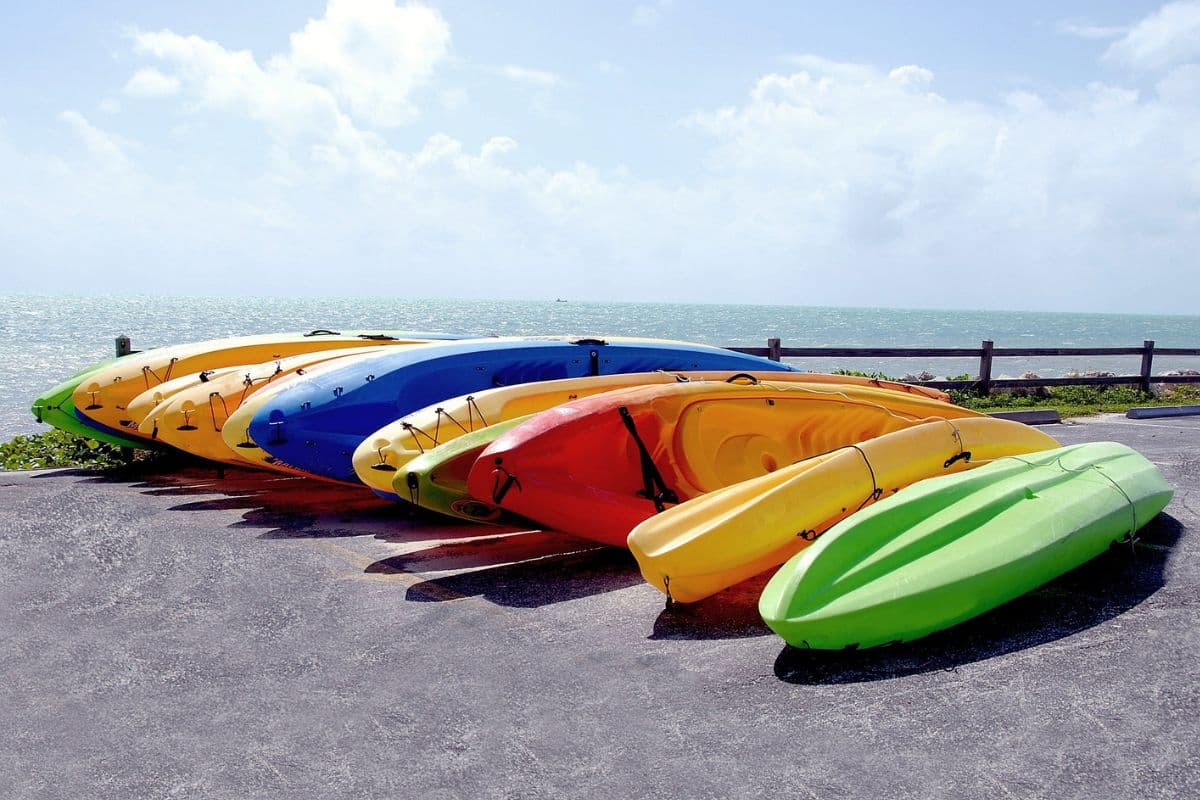
ABS thermoform kayaks are another great option for people who are looking for highly versatile, relatively affordable, and significantly lighter boats that work well in pretty much any type of water.
This kayak’s construction process uses vacuum power to suck heated plastic sheets over and around a kayak mold.
The sheet material is made up of impact-resistant ABS plastic with a very thin protective layer of acrylic on the outer edge.
The result of this construction process leads to kayaks that are relatively lightweight, durable, and straight tracking, and they also won’t break your bank account.
Pros
You get a lot of the same benefits from ABS thermoform kayaks that you are going to get out of a rotomolded plastic kayak, but with up to a 30% weight reduction due to the other materials used in its construction.
Cons
The only real drawback to this kind of kayak is that it may appear a lot faster than it can actually go in the water.
Sure, that outer layer of acrylic material is going to provide a much tougher surface than rotomolded plastic.
However, these kayaks almost always won’t be as fast as those made of carbon fiber or fiberglass, even if their decks and hulls share the same shiny look.
Inflatable Kayaks
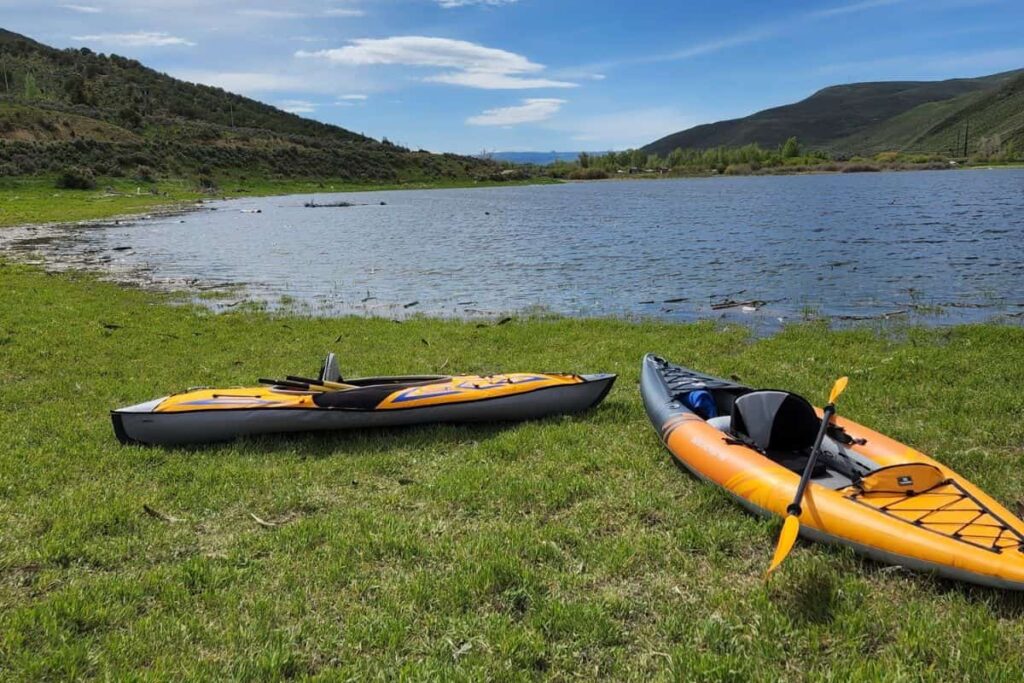
It’s tough to beat the convenience of an inflatable kayak!
You don’t even need a roof rack to transport these handy boats.
These boats are usually made out of poly and nylon blend materials, often called “kayak socks”, and can be blown up the same way you might inflate a pool toy or boat tube — though usually a little bit faster!
The blended materials used to make an inflatable kayak are strong and resilient, giving you a kayak that offers fantastic performance in a variety of water situations.
These might not necessarily be the best option as sea kayaks for tackling any real waves or whitewater rapids, but flat water and even bumpy water on a busy summer lake, will be no problem for these boats.
Pros
If your home has very limited space in your home, especially if you live in an apartment, you can’t beat the stowability and portability of an inflatable kayak, as compared to their fiberglass counterparts.
You can tuck your full-sized (12-foot to 14-foot) inflatable kayak away inside your backpack when not in use, and easily blow it up to full-size in about 60 seconds or less, and hit the water right away!
Complex inflatable kayaks with unique geometry, specialized construction techniques, and durable materials (including fiberglass cloth) can be designed with special tear resistance strong enough to withstand tougher water.
Inflatables aren’t just great as recreational kayaks, but can be built for performance as well.
Cons
Obviously, inflatable kayaks are a bit of a riskier proposition if you’re considering taking them down rapid rivers or streams.
It’s wise to invest in a repair kit to ensure that you’ll be covered in the event of a snag or tear.
Fiberglass tape is a versatile repair tool that can fix a variety of issues that arise.
You always need to be on the lookout for sharp rocks, sharp sticks, and submerged branches.
Fiberglass And Carbon Fiber Kayaks
If you have a decent budget to spend on a premium kayak, chances are pretty good it’ll be made of fiberglass or carbon fiber (or some kind of composite material).
These hardshell kayaks are made for extreme performance.
Many of the best whitewater kayaks are built out of these materials, as are boats made for sea kayaking and those designed for racing in all different kinds of conditions.
These kayaks are super lightweight, very strong, and surprisingly durable, but they’re also likely to set you back a pretty penny.
Most paddlers feel this investment is worth every cent the moment that they dip their kayaks into the water.
Pros
Composite materials tend to be stiffer than other kayak building options, which allows these types of kayaks to track much straighter and be faster than other kinds.
You can get a composite kayak to react to each individual paddle stroke much faster (and far more efficiently) than you with pretty much any other type of kayak.
Most of the “surface damage” suffered by a composite boat can be easily patched up with next to no extra effort or special tools, and maybe 15 minutes of YouTube research.
Best of all is just how incredibly light this type of kayak is, thanks to the synthetic composite construction of its deck and hull.
Even super long kayaks built for racing, tandem operations, or kayaking out in rough ocean water will feel as light as a feather.
Cons
Prepare yourself for the extreme sticker shock that comes with purchasing composite kayak. Seriously.
You’ll find that composite kayaks are some of the most expensive options on the market today.
You’ll need to pony up a decent chunk of change to get your hands on even the least expensive option in this class.
Wooden Kayaks
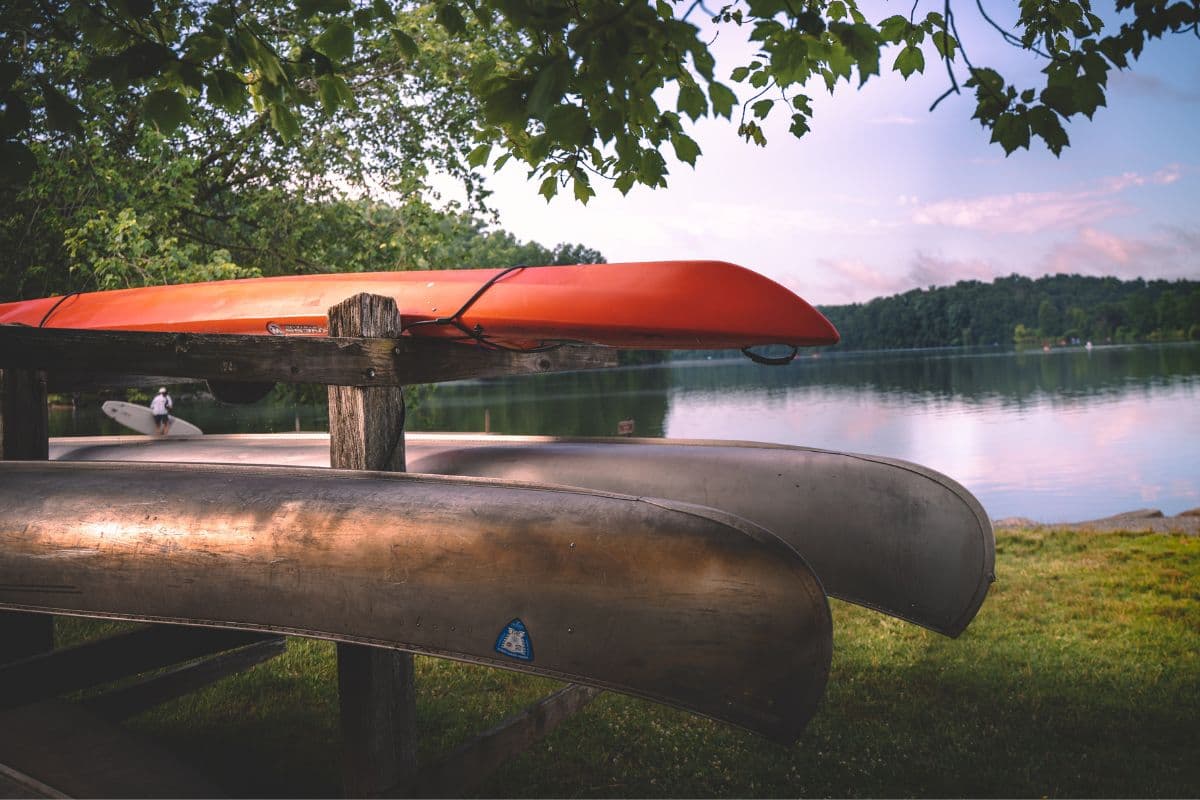
There’s something really beautiful about wooden kayaks, especially if you’re an advanced wood worker who has taken the time to build one yourself.
Wooden kayaks have a totally unique look and feel to them. They also happen to be super light, super responsive, and some of the most versatile options you’ll find on the market today.
A strip built kayak, a boat made out of thin strips of wood, is possibly the most time-consuming vessel to build. Strip built boats are typically covered with an epoxy resin to seal the wood and provide UV resistance.
If you have the opportunity to build one of these yourself, make sure you set aside a couple of months to tackle the manual assembly process, as these kayaks are made over the course of many months. The rewards, though, are going to be immense when you launch a craft you created by hand!
Pros
Straight out of the gate, wooden kayaks are some of the most beautiful crafts on the water today.
Additionally, wooden kayak construction materials are typically lighter than other common kayak materials.
You can shave a lot of weight off of wooden boats that are the exact same size as rotomolded plastic or ABS kayaks, and get some other nice performance boosts, too.
The outer wood layer on this type of kayak makes it highly responsive to your paddle controls.
They also track really straight, and can be fast in the water.
Cons
If you don’t plan to go the DIY route, you’re probably going to end up spending a mountain of money on kayak construction, especially if you’re aiming for a premium design or premium materials.
Secondly, you’re going to have to give this kayak extra special treatment.
Even though the outer surface of this type of kayak (the surface that comes in contact with water) is protected by fiberglass, resin, and other materials, wood is pretty unforgiving when it comes in contact with rocks, branches, and other hard objects.
Every single dent and ding on your kayak’s hull is pretty much going to live there forever, unless you strip off the outer layer and refinish the kayak from top to bottom.
Which kayak material is the strongest?
Most modern kayaks are very strong and resilient, but composite materials and rotomolded plastic take the cake in this department.
The more expensive hard-shell kayaks made from rotomolded plastic are pretty much “bombproof”, but you’ll also be sacrificing real performance with this type.
Composite materials, like those used in a fiberglass kayak, are strong and stiff, but you’re also going to pay a hefty price for the performance enhancements they offer.
What kinds of kayaks are the most affordable?
Rotomolded and ABS kayaks are easily the most cost-efficient options you’ll find when kayak shopping.
These are perfect for beginners, especially those looking to use their kayaks in all kinds of water situations.
Can you take a wooden kayak into whitewater?
There are certainly no rules that say you can’t take a wooden kayak into whitewater situations, but you might want to rethink that decision so you can avoid denting and dinging up a beautiful piece of functional art like this kind of boat on a wild water adventure.
It’s best to use your wooden kayak on flat water only, and leave the “rough stuff” to kayaks that are built for those other kinds of excursions
Conclusion
Before deciding which type of kayak to buy, be sure to also take the kayak’s building materials into account. This will ensure that you get the right boat to fit your specific kayaking needs, and have a great time out on the water!
Table of Contents


